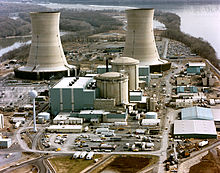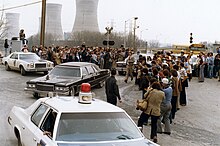Three Mile Island accident



The Three Mile Island accident occurred on March 28th, 1979 at the Three Mile Island Nuclear Power Plant in Pennsylvania. It was "the single most important event in the fifty-year history of nuclear power regulation in the United States". Many people have seen the event as a turning point for the nuclear power industry in the United States.[1] The Three Mile Island power station is near Harrisburg, Pennsylvania. The accident resulted in a partial core meltdown in Unit 2 of the nuclear power plant. Unit 2's pressurized water reactor was of 900 MWe capacity.[2]
The chain of events that led to the crisis at the TMI plant included several minor equipment failures that operator errors drastically compounded, resulting in a major accident.[3][1] The Three Mile Island accident is largely seen as a failure of crisis management.[4] According to one reviewer of the book:
Reactor operators were not trained to deal with accident conditions, and the NRC had not established effective communication with utilities. Moreover, once the accident occurred, the lines of authority proved to be ill defined. The public received conflicting reports that caused needless panic and evacuations. It was these systemic weaknesses in the regulatory system that allowed gifted people to make the mistakes they did.[4]
Large portions of the TMI-2 reactor core melted, though the fact that a partial meltdown had occurred did not become clear until 1985. The greatest source of concern during the TMI crisis was a hydrogen bubble that formed in the top of the pressure vessel which held the core:[3]
Although opinions differed, some reactor experts feared that over time the hydrogen bubble might become flammable or, less likely, explosive by combining with free oxygen in the vessel. If the bubble burned or exploded, it could rupture the pressure vessel and force the damaged reactor core into the containment building. The loss of the vessel would not make a breach of containment inevitable, but it would increase the risk of a disastrous release of radiation.[3]
In the end, the Three Mile Island accident, though it "caused a grave crisis, did not produce a public health disaster". In the face of a core meltdown, the pressure vessel held and there was no breach of the plant's containment structure. Only "tiny amounts of the most dangerous forms of volatile radiation escaped to the atmosphere".[3] The TMI-2 cleanup took 11 years and cost about US$1 billion.[1]
J. Samuel Walker suggests that the TMI accident incited widespread criticism of nuclear power technology, the nuclear industry, and the NRC. Critics faulted the industry and the NRC for their poor performance both before and after the accident. The international attention garnered by the crisis redoubled the determination of, and enhanced the credibility of, the anti-nuclear movement. Arguably, the United States nuclear industry has never recovered.[5]
Walker reports that studies looking for long-term radiation effects resulting from the accident have reached conflicting conclusions, but it seems that any increase in cancers is slight enough to have occurred by chance.[1]
Notes[change | change source]
- ↑ 1.0 1.1 1.2 1.3 Bernero, Robert M. March Madness (Book review) Archived 2007-08-08 at the Wayback Machine American Scientist, November–December 2004. Retrieved 1 February 2008.
- ↑ World Nuclear Association (1999). Three Mile Island: 1979 Archived 2013-02-17 at the Wayback Machine Retrieved 19 February 2008.
- ↑ 3.0 3.1 3.2 3.3 Walker, J. Samuel. (March 18, 2009). Documenting Three Mile Island Bulletin of the Atomic Scientists.
- ↑ 4.0 4.1 Wellock, Thomas R. (22 September 2005). "Three Mile Island: A Nuclear Crisis in Historical Perspective (Book review)". The Historian. 67. doi:10.1111/j.1540-6563.2005.00122.x. S2CID 218500122.
- ↑ Barber, John F. (1 December 2004). "Three Mile Island: A Nuclear Crisis in Historical Perspective (Review)". Leonardo online. Archived from the original on 21 July 2011. Retrieved 18 May 2008.
